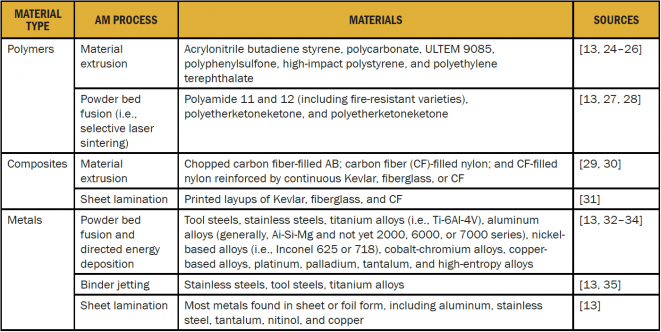INTRODUCTION
Additive manufacturing (AM) is causing a fundamental manufacturing paradigm shift that is changing how aircraft are now maintained and sustained. Sustaining an aging aerospace fleet is an enormous challenge. The U.S. Department of Defense maintains nearly $100 billion worth of spare parts and has to balance avoiding excess inventory [1] while simultaneously preventing stock-out [2]. A large 747-type aircraft can have nearly 6 million individual parts produced by a global supply chain of approximately 550 companies, some of which may not exist a decade from now [3]. Sustainment organizations struggle with long lead times, resulting in maintenance delays or grounded aircraft. For example, the Oklahoma City Air Logistics Complex reported lead times as long as 800 days for constant speed drive castings [4]. Meanwhile, at the end of 2016, 29% of all U.S. Marine Corps F/A-18 Hornets were grounded pending spare parts [5].
AM emerged as a potential solution to reduce both lead times and inventory costs. The technology is well suited for fabricating low-volume, customized, and complex components [2, 6–8]. An analysis of the global aerospace maintenance, repair, and overhaul market identified that if 15% of replacement parts could be produced with AM, over $1 billion in materials and transportation-related savings could be realized; commercial airlines would see $250 million in additional liquidity as a result of reduced inventory costs [9]. Moreover, these analyses were only predicated on printed replacement parts and did not include the additional benefits of three-dimensional (3D) printed tooling, fixtures, jigs, or prototypes [9].
AM is also beneficial for part count reduction and weight savings. Since AM creates parts layer by layer, complex shapes can be designed and fabricated. This would not be possible with conventional methods [7]. For example, a geometrically-complex part fabricated traditionally may be designed as multiple parts which are then joined or assembled. Alternatively, by using AM, this assembly can be consolidated into a single piece and reduce assembly costs. Another example would be reducing the part’s weight by only depositing material where it is required for strength and stiffness. Mathematical tools can optimize the topology (i.e., shape) [10] or integrate lattice structures [11] in order to reduce weight without compromising performance.
The aerospace, medical, and automotive industries adopted AM early [12]. In 2017, the aerospace sector comprised nearly 19% of the AM market [13]. In the U.S. Air Force, the three air logistics complexes integrated AM into aircraft maintenance and sustainment efforts [14]. The U.S. Navy concluded that $1.49 billion would be saved annually on staffing and organizational costs by applying AM within maintenance programs [15]. Companies such as Boeing, Lockheed Martin, General Electric, and Airbus demonstrated how AM can reduce lead times, component weight, operational costs, and environmental impacts [16]. General Electric (GE) invested $1.5 billion in AM, including research and development, implementing 3D printing technology, and production [17].
AM PROCESSES AND AEROSPACE MATERIALS
Seven AM process categories [18] have been identified, and various materials can be fabricated through AM in each (see Table 1 and Figure 1). The resulting mechanical performance has improved due to advanced materials and improving manufacturing processes. Lightweighting is critical for aerospace structures. Lightening plate and web structures through traditional machining from thick billet requires an estimated 6 lbs of billet needed for every 1 lb of material contained within the final part (or a 6:1 “buy-to-fly” ratio) [19]. AM produces near net shape parts, resulting in significantly reducing this ratio [20].
Table 1: Process Categories of AM as Defined by ISO/ASTM 52900-15 [18]

Figure 1: Examples Representing Each of the ASTM/ISO 52900-15 Categories of AM Equipment (Sources: Carbon and Impossible Objects, Youngstown State University and University of Texas at El Paso).
A diversity of materials can be made using AM, including polymers, metals, ceramics, sand, paper, and composites [13, 21–23]. Materials and processes most relevant to aerospace maintenance and sustainment are shown in Table 2.
Table 2: Aerospace Relevant Materials Produced Using Additive Manufacturing
APPLICATIONS SPECIFIC TO AEROSPACE MAINTENANCE AND SUSTAINMENT
With the multiple AM processes and functional materials available, the aerospace industry is using the technology for many applications specific to maintenance and sustainment. The next subsections explore how the aerospace sector is currently using AM.
Prototyping
One of the original applications for AM is rapid prototyping for fit checks, with significant utility in aerospace maintenance and repair [36]. For example, Fleet Readiness Center (FRC) Southwest created a prototype of a tub-fitting reinforcement. Once the fit was verified, the part was machined out of aluminum [37]. As computer numerical control (CNC) machining is time consuming, relatively labor-intensive (especially for programming), and possibly capacity-constrained, AM prototypes (Figure 2) can prevent waste due to incorrect geometries or dimensional tolerances.
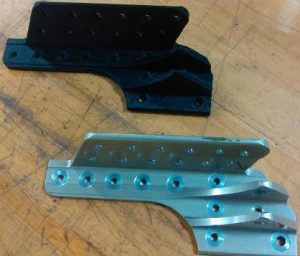
Figure 2: A Drill Guide Built With a Desktop Material Extrusion Printer (Source: Darrell Wallace).
Tooling, Fixtures, and Jigs
The “low-hanging fruit” of AM is the reduction in cost and time for aerospace maintenance and sustainment through fabricating tooling, fixtures, and jigs. The benefits can be realized nearly immediately without the qualification and certification challenges associated with AM end-use parts. For each aerospace vehicle, hundreds of fixtures, guides, templates, and gauges can be printed with AM, reducing cost and lead time by 60–97% [38, 39]. An industrial supplier for composite parts has identified 79% savings in cost and 96% savings in lead time by replacing CNC machining with material extrusion to produce tooling [40].
In addition to cost and lead-time savings, AM tooling can be large. In 2016, Oak Ridge National Laboratory (ORNL) produced a 777X composite wing trim and drill guide using Big Area Additive Manufacturing, as shown in Figure 3. At that time, the structure was the largest 3D printed object ever and leveraged the carbon-reinforced polymer processing from ORNL [41].
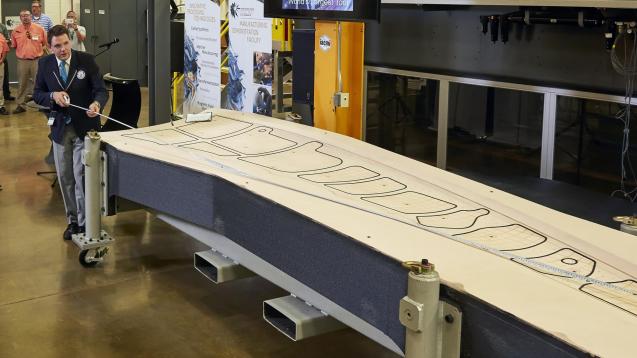
Figure 3: One of the Largest AM-Produced Parts in the World (Source: Oak Ridge National Laboratory).
Military maintenance and sustainment organizations have also leveraged AM for tooling. Since 2006, the FRC-East Cherry Point has supported the fleet by using AM to create custom tooling [42] and demonstrated material extrusion printed tooling for sheet metal press and stretch forming and composite layup tooling [26]. AM tooling was used to return an AV-8B to flight that was damaged during a hard landing at sea, with polycarbonate material extrusion tooling used to press form sheet metal doublers required for the repair [26].
Aerospace metal castings can also take advantage of AM tooling in an industry where lead times of 10–12 months are common [43]. A team from Autodesk and Aristocast designed a modulating matrix structure for an investment casting pattern to cast a super-light airplane seat frame (shown in Figure 4). The computer-optimized, lattice structure provided a 35% lighter seat while meeting performance specifications. The frame was cast in magnesium, resulting in a total weight savings of 56% compared to conventional aluminum subtractive manufacturing.
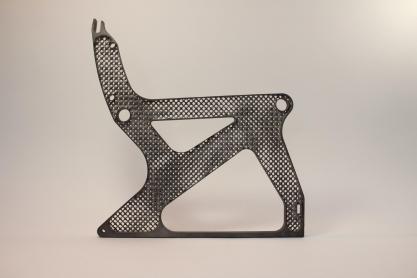
Figure 4: An AM-Enabled Magnesium Investment Casting of an Airbus Seat Frame (Source: Autodesk).
Binder jetting is used to create tooling for sand casting. When AM is used for core fabrication, material scrap can be reduced by 90% compared to traditional manufacturing [44]. Other benefits of AM sand casting are reductions in lead time and cost, improved functionality, and increased customization [44]. AM for casting tooling improves lead times and decreases costs by eliminating the need for a hard pattern. Complex geometries enabled by AM-printed sand molds can reduce weight or improve designs for thermal dissipation. Furthermore, when AM tooling enables part consolidation of castings, the new cast part can have increased durability by eliminating welds or fasteners.
Repair
AM is utilized for repairing metal aircraft engine parts such as turbine engine parts, blades, compressors, and housings. When a part is worn or broken, the part is normally scrapped and a new part manufactured; however, with AM, the lifetime of the part can be extended [45]. Parts are repaired by removing the damaged material area and reconstructing the part using the undamaged area [46]. The most common AM process for repair is directed energy deposition (DED). The value of AM repair is impacted by factors such as inspection for defects, the ability to repair the part in the field, the speed and cost of alternative repair techniques, and the requirement to restore the part to the original form with the same mechanical properties [47].
Laser Engineered Net Shaping (LENS) from Optomec successfully repaired parts used in gas turbine engines [45]. Repairing a bearing housing using LENS was only 50% of the cost of buying a new housing, with the lead time decreasing from several weeks to a few days [48]. One particularly dramatic example is BeAM, a European manufacturer of DED machines, which repaired over 800 aerospace parts and extended the life of the part from 10,000 to 60,000 hours [49].
When AM is used for core fabrication, material scrap can be reduced by 90% compared to traditional manufacturing.
End-Usable Parts
Another application for aerospace and defense is the direct fabrication of end-usable parts. One of the most visible examples of metal AM parts for maintenance and sustainment has been the U.S. Naval Air Systems Command’s (NAVAIR’s) demonstration of a titanium link and fitting assembly for the engine’s nacelle on the V-22 Osprey aircraft (shown in Figure 5). This part had to undergo extensive materials and performance testing for qualification and certification before being placed on the aircraft [50, 51].
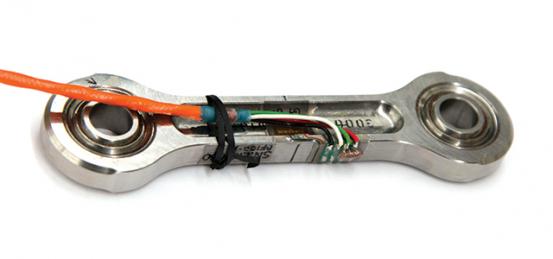
Figure 5: Titanium Link and Fitting Assembly for the V-22 (Source: Noel Hepp, U.S. Navy).
A plastic material extrusion desktop 3D printer was used by the U.S. Marines on the USS Wasp to make a replacement plastic bumper for an F-35B landing gear door (see Figure 6). In the left photo of the figure, CWO2 Daniel Rodriguez is holding the 3D printed plastic F-35B landing gear bumper for an F-35B Lightning II. On the right is Sgt. Adrian Willis demonstrating the 3D printer used to print the bumper part. This replacement part saved $70,000 and several days, as the only way to replace the bumper without 3D printing would have been to order and ship a complete door to the Wasp [52].
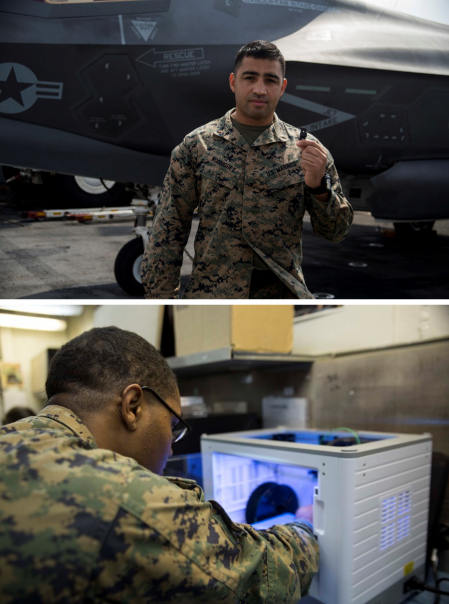
Figure 6: (Top) CWO2 Rodriguez Holding the Bumper and (Bottom) Sgt. Willis Demonstrating the 3D Printer (Source: U.S. Marine Corps Photos by Cpl. Stormy Mendez).
AM also enables complex designs where material is added only where needed to provide strength, stiffness, interface, or manufacturability requirements; the design freedom can lead to weight savings. One design team analyzed the benefits of AM for a commercial airplane seat buckle redesigned to save energy and weight. By redesigning for AM, the weight dropped from 155 g to 68 g. With 853 seats in an Airbus A380, the replacement design would recover a total of a 74 kg, resulting in a lifetime savings of 3,300,000 liters of fuel [53].
GE Aviation demonstrated the combined benefits of weight savings and part consolidation in the next-generation, additively-manufactured LEAP fuel nozzle. The nozzles were redesigned from a 20-part assembly to a single component, with a 25% weight reduction. Not only were the nozzles lighter, but more durable and 5x stronger than the original design [54–55]. GE plans to manufacture up to 100,000 parts with AM by 2020 [16].
AM is also revolutionizing manufacturing in space. The National Aeronautics and Space Administration (NASA) has identified AM for remote manufacturing for sustainment of long-duration missions and human exploration [56]. The Made In Space material extrusion printer was installed on the International Space Station (ISS) in November 2014, later followed in March 2016 by the installation of the more capable Additive Manufacturing Facility (AMF) at the ISS [57]. Another exciting application area of AM in space is the potential to print and deploy satellites in orbit, potentially providing a means of reconstituting satellite constellations degraded due to age, natural damage, or combat [58–59].
QUALIFICATION AND CERTIFICATION
The aerospace industry uses qualification, certifications, and quality controls in order to ensure public safety. The qualification and certification process for aircraft components can cost over $130 million and take up to 15 years, as shown in Figure 7 for a traditional Federal Aviation Administration (FAA) certification approach [32, 60]. Using AM for direct-part production presents a challenge for qualification and certification, especially for critical components [60]. The AM process is relatively new and, consequently, has few standards and minimal flight heritage. Therefore, many companies, organizations, and the government are encouraging the creation of standards [32, 61]. Studies have estimated for one given AM process, there are over a hundred variables that need to be controlled to produce stable and repeatable parts [62]. The lack of AM standards results in several barriers for AM implementation—material data are not comparable between companies, different process parameters are used by various AM machine operators, repeatability of results can be insufficient, and few specifications exist to ensure a product is built as specified [8].
![Figure 7: The Traditional FAA Building Block Test Approach for Certification [60].](/wp-content/uploads/2019/11/figure_7_martof_amforaero_dsiac_spring_2019_with_color-515x248.png)
Figure 7: The Traditional FAA Building Block Test Approach for Certification [60].
The FAA established the Additive Manufacturing National Team to collaborate with industry, academia, and government agencies in applying current FAA regulations to AM products and developing guidelines to certify structure safety. One of the first metal AM parts certified by the FAA was GE Aviation’s T25 sensor housing. GE designed, prototyped, produced, and certified this part in only 4 months and initiated a retrofit on 400 fielded engines [54].
In metal AM processes like powder bed fusion, unique material issues exist that impact qualification and certification. Mechanical properties are not uniform within a part. Inherent material anomalies could affect fracture toughness and fatigue (i.e., cyclic loading) strength, including lack of fusion, distributed porosity, inclusions, and residual stress [33]. For AM, an important step in process qualification is monitoring the AM process during part builds to identify process errors detrimental to the component. Research is ongoing to detect defects while a metal AM build is in progress [63].
Collaboration is necessary to accelerate adopting AM and address qualification and certification issues. America Makes, a public-private partnership established by the federal government, has focused on addressing AM challenges through government, industry, and academia collaboration [64, 65]. In 2016, America Makes and American National Standards Institute (ANSI) formed the Additive Manufacturing Standardization Collaborative (AMSC) to bring together Standards Development Organizations such as American Society for Testing and Materials (ASTM) International, American Welding Society, Institute of Electrical and Electronics Engineers (IEEE), and the International Organization for Standardization (ISO). In February 2017, the first version of a standards roadmap was completed [66]. This roadmap listed existing standards and specifications for AM, identified AM-related standards in development, and outlined gaps where new standards are needed.
CONCLUSION
AM is a suite of manufacturing processes that can reduce maintenance time and costs through prototyping, tooling, fixtures, jigs, part repair, and spare part production. Reductions in lead time, cost, and improved buy-to-fly ratio are realized today. If design changes are permitted, then complex geometric lightweight parts will enable energy-saving and positive environmental impact.
Challenges still need to be overcome to enable more widespread adoption of AM, including process control, geometric tolerances, quality assurance, and repeatability [67, 68]. Process control, known material properties, and confidence in repeatedly obtaining these properties are needed for certification authorities when dealing with flight-critical parts [24, 32]. AM designing is another obstacle. Engineers taught design approaches for traditional manufacturing now need to adapt to leverage the design freedoms of AM [14, 45]. One study revealed barriers to adopting AM, including cost, lack of trained talent, uncertainty of quality of final product, and printer speed [69].
AM will inevitably play a greater role in aerospace production, maintenance, and sustainment.
The needs for maintenance and sustainment are substantial, particularly for legacy fleets. The perceived benefits of AM outweigh the challenges. As a result, AM will inevitably play a greater role in aerospace production, maintenance, and sustainment.
Acknowledgments:
This effort was performed through the National Center for Defense Manufacturing and Machining under the America Makes Program titled “Maturation of Advanced Manufacturing for Low Cost Sustainment (MAMLS)” and is based on research sponsored by the U.S. Air Force Research Laboratory under agreement number FA8650-16-2-5700.
References:
- Merritt, Z. D. “Defense Inventory: Services Generally Have Reduced Excess Inventory, but Additional Actions Are Needed.” U.S. Government Accountability Office; report no. GAO 1 5-350, April 2015.
- Sirichakwal, I., and B. Conner. “Implications of Additive Manufacturing for Spare Parts Inventory.” 3D Printing and Additive Manufacturing, vol. 3, pp. 56–63, 2016.
- Pickup, J. “Boeing Celebrates Delivery of 50th 747-8.” Boeing MediaRoom, http://boeing.mediaroom.com/2013-05-29-Boeing-Celebrates-Delivery-of-50t…, accessed 29 May 2013.
- Tinker AFB Public Affairs. “422nd SCMS Provides Key Support to the Warfighter – The Tinker Take Off.” http://journalrecord.com/tinkertakeoff/2014/09/25/422nd-scms-provides-ke…, 2014.
- Seck, H. H. “Spare Parts Shortage Grounds Many Marine Corps Aircraft.” https://www.military.com/daily-news/2017/02/10/spare-parts-shortage-grou…, accessed 28 December 2017.
- Marchese, K., J. Crane, and C. Haley. “3D Opportunity for the Supply Chain: Additive Manufacturing Delivers.” https://www2.deloitte.com/insights/us/en/focus/3d-opportunity/additive-m…, September 2015.
- Conner, B. P., G. P. Manogharan, A. N. Martof, L. M. Rodomsky, C. M. Rodomsky, D. C. Jordan, et al. “Making Sense of 3-D Printing: Creating a Map of Additive Manufacturing Products and Services.” Additive Manufacturing, vol. 1–4, pp. 64–76, 2014.
- Huang, Y., and M. C. Leu. “Frontiers of Additive Manufacturing Research and Education—Report of NSF Additive Manufacturing Workshop.” Center for Manufacturing Innovation, University of Florida, pp. 1–35, March 2014.
- McCutcheon, R., R. Pethick, B. Bono, and M. Thut. “3D Printing and the New Shape of Industrial Manufacturing.” Price Waterhouse Coopers, 2014.
- Brackett, D., I. Ashcroft, and R. Hague. “Topology Optimization for Additive Manufacturing.” Proceedings of the Solid Freeform Fabrication Symposium, Austin, TX, pp. 348–362, 2011.
- Cheng, L., P. Zhang, E. Biyikli, J. Bai, J. Robbins, and A. To. “Efficient Design Optimization of Variable-Density Cellular Structures for Additive Manufacturing: Theory and Experimental Validation.” Rapid Prototyping Journal, vol. 23, pp. 660–677, 2017.
- Huang, R., M. Riddle, D. Graziano, J. Warren, S. Das, S. Nimbalkar, et al. “Energy and Emissions Saving Potential of Additive Manufacturing: The Case of Lightweight Aircraft Components.” J. Clean Prod., vol. 135, pp. 1559–1570, 2016.
- Wohlers, T. “Wohlers Report 2018.” Wohlers Associates, Inc., 2018.
- Kira. “U.S. Air Force to Integrate 3D Printing Into Almost All Aspects of Aircraft Design and Maintenance.” http://www.3ders.org/articles/20151021-us-air-force-to-integrate-3d-prin…. html, accessed 13 January 2016.
- Byron, A. J. “Qualification and Characterization of Metal Additive Manufacturing.” Massachusetts Institute of Technology. http://dspace.mit.edu/handle/1721.1/104315, 2016.
- Markets, S. “Additive Manufacturing in Aerospace: Strategic Implications.” White paper, http://www.smartechpublishing.com, 2014.
- Benedict. “GE Moves Forward With Takeover of 3D Printing Companies Arcam AB, Concept Laser.” http://www.3ders.org/articles/20161214-ge-moves-forward-with-takeover-of…, accessed 21 February 2017.
- ISO/ASTM 52900-15. “Standard Terminology for Additive Manufacturing – General Principles – Terminology.” ASTM International, West Conshohocken, PA, 2015.
- Bihlman, B. “Aerospace Materials and Design.” Aerospace Manufacturing and Design, http://www.aero-spacemanufacturinganddesign.com/article/amd1015-aerospac…, accessed 23 March 2017.
- Dehoff, R., C. Duty, W. Peter, Y. Yamamoto, C. Wei, C. Blue, et al. “Case Study: Additive Manufacturing of Aerospace Brackets.” Adv. Mater. Processes, vol. 171, pp. 19–22, 2013.
- Campbell, T., C. Williams, O. Ivanova, and B. Garrett. “Could 3D Printing Change the World?” Technologies, Potential, and Implications of Additive Manufacturing, Atlantic Council, Washington, DC, http://www.cbpp.uaa. alaska.edu/afef/Additive%20MFG%20.pdf, 2011.
- Gibson, I., D. Rosen, and B. Stucker. Additive Manufacturing Technologies: 3D Printing, Rapid Prototyping, and Direct Digital Manufacturing. Springer, 2014.
- Thomas, D. S., and S. W. Gilbert. “Costs and Cost Effectiveness of Additive Manufacturing.” National Institute of Standards and Technology, December 2014.
- Guo, N., and M. C. Leu. “Additive Manufacturing: Technology, Applications and Research Needs.” Front Mech. Eng. Chin., Springer Berlin Heidelberg, vol. 8, pp. 215–243, 2013.
- Perez, M., M. Block, D. Espalin, R. Winker, T. Hoppe, F. Medina, et al. “Sterilization of FDM-Manufactured Parts.” Proceedings of the 2012 Annual International Solid Freeform Fabrication Symposium, Austin, TX, pp. 6–8, August 2012.
- Greenwood, D., and R. Francis. Fleet Readiness Centers. NAVAIR Additive Manufacturing Industry Day, http://www.navair.navy.mil/osbp/index.cfm?fuseaction=home.download&id=596, 24 July 2014.
- Lyons, B. “Additive Manufacturing in Aerospace: Examples and Research Outlook.” Bridge, vol. 44, https://trid.trb.org/view.aspx?id=1328197, 2014.
- Gonzalez, P. A. “High Temperature Laser Sintering Technologies for Air and Space Vehicles.” Euromold 2015, Dusseldorf, Germany, 25 September 2015.
- Love, L. J., V. Kunc, O. Rios, C. E. Duty, A. M. Elliott, B. K. Post, et al. “The Importance of Carbon Fiber to Polymer Additive Manufacturing.” J. Mater. Res., Cambridge University Press, vol. 29, pp. 1893–1898, 2014.
- Goehrke, S. A. “Markforged Expands Industrial 3D Printer Line: CEO Details Accessibility in Local Manufacturing.” https://3dprint.com/184188/markforged-indus-trial-x-line/, accessed 21 August 2017.
- Goehrke, S. A. “Impossible Objects Presents Model One 3D Printer, Tells Us Their Composite-Based Additive Manufacturing Will Compete With Injection Molding.” https://3dprint.com/173381/impossible-objects-model-one/, accessed 21 August 2017.
- Frazier, W. E. “Metal Additive Manufacturing: A Review.” J. Mater. Eng. Perform, Springer, vol. 23, pp. 1917–1928, 2014.
- Seifi, M., M. Gorelik, J. Waller, N. Hrabe, N. Sham-saei, S. Daniewicz, et al. “Progress Towards Metal Additive Manufacturing Standardization to Support Qualification and Certification.” JOM, Springer, vol. 69, pp. 439–455, 2017.
- Lewandowski, J. J., and M. Seifi. “Metal Additive Manufacturing: A Review of Mechanical Properties.” Annu. Rev. Mater. Res., vol. 46, pp. 151–186, 2016.
- 3D-Printing Milestone. “Puris 3D Prints Largest Titanium Part.” http://www.businesswire.com/news/home/20160120006401/en/3D-Printing-Milestone-Puris-3D-Prints-Largest-Titanium, accessed 3 April 2017.
- Khajavi, S. H., J. Partanen, and J. Holmström. “Additive Manufacturing in the Spare Parts Supply Chain.” Comput. Ind., vol. 65, pp. 50–63, 2014.
- Myers, M. “3-D Printers Save Time, Money in Major Aircraft Repairs.” Navy Times, https://www.navytimes. com/story/military/tech/2015/03/21/navy-aircraft-3d-printing-repairs-fa-18/24959201/, accessed 3 April 2017.
- Hiemenz, J. “Additive Manufacturing Trends in Aerospace.” White paper, Stratasys, pp. 1–11, 2014.
- Taylor, S. “Stratasys & Whale Create 97% Lead Time Reduction With 3D Printing.” 3D Printing Industry, https://3dprintingindustry.com/news/stratasys-whale-cre-ate-97-lead-time…, accessed 11 April 2017.
- Stratasys. “Additive Manufacturing Reduces Tooling Cost and Lead Time to Produce Composite Aerospace Parts.” http://www.stratasys.com/resources/case-stud-ies/aerospace/acs, 2015.
- Shoemaker, S., and J. Bernales. “3D Printed Tool for Building Aircraft Achieves Guinness World Records, Oak Ridge National Laboratory.” https://www.ornl.gov/news/3d-printed-tool-building-aircraft-achieves-gui…, accessed 21 August 2017.
- Scheck, C. E., J. N. Wolk, W. E. Frazier, B. T. Mahoney, K. Morris, R. Kestler, et al. “Naval Additive Manufacturing: Improving Rapid Response to the Warfighter.” Nav. Eng. J., vol. 128, pp. 71–75, 2016.
- Dordlofva, C., A. Lindwall, and P. Törlind. “Opportunities and Challenges for Additive Manufacturing in Space Applications.” DS 85-1: Proceedings of NordDesign 2016, Trondheim, Norway, vol. 1, https://www.designsoci-ety.org/publication/39317/ opportunities_and_challenges_for_additive_manufacturing_in_space_applications, 10–12 August 2016.
- Cotteleer, M., M. Neier, and J. Crane. 3D Opportunity for Tooling: Additive Manufacturing Shapes the Future. Deloitte University Press, April 2014.
- Guo, N., and M. C. Leu. “Additive Manufacturing: Technology, Applications and Research Needs.” Front. Mech. Eng. Chin., vol. 8, pp. 215–243, 2013.
- Portolés, L., O. Jordá, L. Jordá, A. Uriondo, M. Esperon-Miguez, and S. Perinpanayagam. “A Qualification Procedure to Manufacture and Repair Aerospace Parts With Electron Beam Melting.” Journal of Manufacturing Systems, vol. 41, pp. 65–75, 2016.
- Kobryn, P. A., N. R. Ontko, L. P. Perkins, and J. S. Tiley. “Additive Manufacturing of Aerospace Alloys for Aircraft Structures.” DTIC document, http://oai.dtic.mil/oai/oai?verb=getRecord&metadataPrefix=html&identifier =ADA521726, 2006.
- Mudge, R. P., and N. R. Wald. “Laser Engineered Net Shaping Advances Additive Manufacturing and Repair.” Welding Journal-New York, http://www.rpm-innovations. com/laser_deposition_technology_advances_additive_ manufacturing_and_repair, 2007.
- Charron, K. “BeAM Repairs More Than 800 Aero-space Parts With Industrial Metal 3D Printers.” https://www.3ders.org/articles/20160204-beam-repairs-more-than-800-aeros…, accessed 26 December 2017.
- NAVAIR Public Affairs Office. “NAVAIR Marks First Flight With 3-D Printed, Safety Critical Parts.” http://www.navair.navy.mil/index.cfm?fuseaction=home.printnewsstory&id=6323, 2016.
- Freedberg, S. J., Jr. “First Osprey Flight With Critical 3D Printed Part.” Breaking Defense, http://breakingdefense.com/2016/08/osprey-takes-flight-with-3d-printed-p…, accessed 18 April 2017.
- Mendez, S. “Marines Use 3-D Printer to Make Replacement Part for F-35 Fighter.” U.S. Department of Defense News, https://dod.defense.gov/News/Article/Article/1498121/marines-use-3-d-pri…, accessed 30 September 2018.
- 3T R. “SAVING Project – Saving Litres of Aviation Fuel.” 3TRP, https://www.3trpd.co. uk/portfolio/saving-project-saving-litres-of-aviation-fuel/, accessed 4 October 2016.
- Kellner, T. “The FAA Cleared the First 3D Printed Part to Fly in a Commercial Jet Engine From GE.” GE Reports, http://www.gereports.com/post/116402870270/the-faa-cleared-the-first-3d-…, accessed 25 January 2016.
- Ford, S., and M. Despeisse. “Additive Manufacturing and Sustainability: An Exploratory Study of the Advantages and Challenges.” J. Clean Prod., vol. 137, pp. 1573–1587, 2016.
- NASA. “Additive Manufacturing: Pioneering Afford-able Aerospace Manufacturing.” https://www.nasa.gov/sites/default/files/atoms/files/additive_mfg.pdf, 2016.
- AMF. “Made in Space.” http://www.madeinspace.us/projects/amf/, accessed 21 February 2017.
- Kwas, A., E. MacDonald, C. J. Kief, R. Wicker, C. Soto, L. Bañuelos, et al. “Printing Multi-Functionality: Additive Manufacturing for CubeSats.” AIAA Space 2014 Conference and Exposition, 2014.
- Lyke, J. C. “Plug-and-Play Satellites.” IEEE Spectrum, vol. 49, pp. 36–42, 2012.
- Mies, D., W. Marsden, and S. Warde. “Overview of Additive Manufacturing Informatics: A Digital Thread.” Integrating Materials and Manufacturing Innovation, vol. 5, December 2016.
- Merissa, P., CSU, and S. Alexander. “Additive Manufacturing: A Summary of the Literature.” http://engaged-scholarship.csuohio.edu/urban_facpub/1319/, 2015.
- Kabbara, J. “Additive Manufacturing [Internet].” Gorham PMA and DER Conference 2015; San Diego, CA, http://gorham-tech.com/yahoo_site_admin/assets/docs/FAA_Additive_Manufac…. pdf, 24 March 2015.
- Nassar, A. R., T. J. Spurgeon, and E. W. Reutzel. “Sensing Defects During Directed-Energy Additive Manufacturing of Metal Parts Using Optical Emissions Spectroscopy.” Solid Freeform Fabrication Symposium Proceedings, University of Texas, Austin, TX, http://sffsymposium.engr.utexas.edu/sites/default/files/2014-024-Nassar.pdf, 2014.
- Swenson, G. “National Additive Manufacturing Innovation Institute Announced.” NIST, https://www. nist.gov/news-events/news/2012/08/national-additive-manufacturing-innovation-institute-announced, accessed 29 December 2017.
- Good, A. “About – America Makes.” America Makes, https://www.americamakes.us/about/, accessed 29 December 2017.
- America Makes and ANSI AMSC. “Standardization Roadmap for Additive Manufacturing.” ANSI/National Center for Defense Manufacturing and Machining, https://www.ansi.org/standards_activities/standards_boards_ panels/amsc/Default?menuid=3, February 2017.
- Cotteleer, M., S. Trouton, and E. Dobner. “3D Opportunity and the Digital Thread.” DU Press, https://du-press.deloitte.com/dup-us-en/focus/3d-opportunity/3d-printing…, accessed 30 December 2016.
- U.S. Department of Energy. “Additive Manufacturing: Pursuing the Promise.” https://energy.gov/sites/prod/files/2013/12/f5/additive_manufacturing.pdf, 2012.
- PricewaterhouseCoopers. “3D Printing Comes of Age in U.S. Industrial Manufacturing.” http://www.pwc. com/us/en/industrial-products/publications/assets/pwc-next-manufacturing-3d-printing-comes-of-age.pdf, 2016.


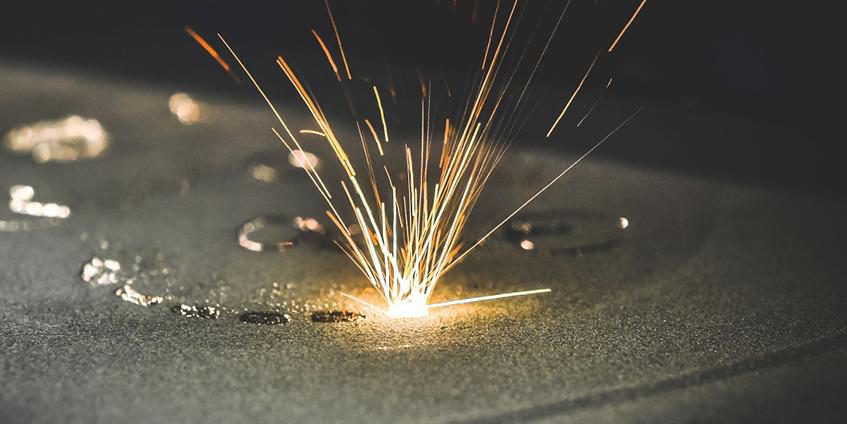
![Table 1: Process Categories of AM as Defined by ISO/ASTM 52900-15 [18]](/wp-content/uploads/2019/11/table_1_martof_amforaero_-521x287.png)
